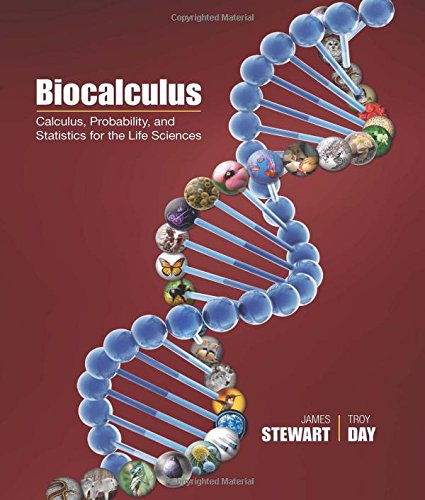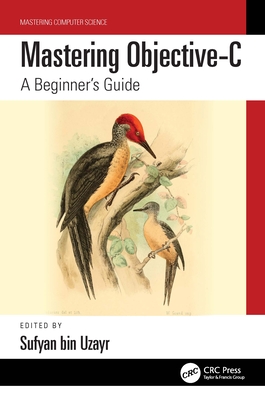图书简介
BIOCALCULUS: CALCULUS, PROBABILITY, AND STATISTICS FOR THE LIFE SCIENCES shows students how calculus relates to biology, with a style that maintains rigor without being overly formal. The text motivates and illustrates the topics of calculus with examples drawn from many areas of biology, including genetics, biomechanics, medicine, pharmacology, physiology, ecology, epidemiology, and evolution, to name a few. Particular attention has been paid to ensuring that all applications of the mathematics are genuine, and references to the primary biological literature for many of these has been provided so that students and instructors can explore the applications in greater depth. Although the focus is on the interface between mathematics and the life sciences, the logical structure of the book is motivated by the mathematical material. Students will come away with a sound knowledge of mathematics, an understanding of the importance of mathematical arguments, and a clear understanding of how these mathematical concepts and techniques are central in the life sciences.
PROLOGUE: MATHEMATICS AND BIOLOGY.
CASE STUDIES.
Case Study 1: Kill curves and antibiotic effectiveness.
Case Study 2: Hosts, parasites, and time travel.
Chapter 1 Functions and Sequences.
1.1 Four Ways to Represent a Function.
1.2 A Catalog of Essential Functions.
1.3 New Functions from Old Functions.
Project: The Biomechanics of Human Movement.
1.4 Exponential Functions.
1.5 Logarithms; Semi-log and Log-log Plots.
Project: The Coding Function of DNA.
1.6 Sequences and Difference Equations.
Project: Drug Resistance in Malaria.
Review.
Case Study 1a: Kill curves and antibiotic effectiveness.
Chapter 2 Limits.
2.1 Limits of Sequences.
Project: Modeling the Dynamics of Viral Infections.
2.2 Limits of Functions at Infinity.
2.3 Limits of Functions at Finite Numbers.
2.4 Limits: Algebraic Methods.
2.5 Continuity.
Review.
Case Study 2a: Hosts, parasites, and time travel.
Chapter 3 Derivatives.
3.1 Derivatives and Rates of Change.
3.2 The Derivative as a Function.
3.3 Basic Differentiation Formulas.
3.4 The Product and Quotient Rules.
3.5 The Chain Rule.
3.6 Exponential Growth and Decay.
Project: Controlling Red Blood Cell Loss During Surgery.
3.7 Derivatives of the Logarithmic and Inverse Tangent Functions.
3.8 Linear Approximations and Taylor Polynomials.
Project: Harvesting Renewable Resources.
Review.
Case Study 1b: Kill curves and antibiotic effectiveness.
Chapter 4 Applications of Derivatives.
4.1 Maximum and Minimum Values.
Project: The Calculus of Rainbows.
4.2 How Derivatives Affect the Shape of a Graph.
4.3 L’’Hopital’’s Rule: Comparing Rates of Growth.
Project: Mutation-Selection Balance in Genetic Diseases.
4.4 Optimization.
Project: Flapping and Gliding.
Project: The Tragedy of the Commons: An Introduction to Game Theory.
4.5 Recursions: Equilibria and Stability.
4.6 Antiderivatives.
Review.
Chapter 5 Integrals.
5.1 Areas, Distances, and Pathogenesis.
5.2 The Definite Integral.
5.3 The Fundamental Theorem of Calculus.
Project: The Outbreak Size of an Infectious Disease.
5.4 The Substitution Rule.
5.5 Integration by Parts.
5.6 Partial Fractions.
5.7 Integration Using Tables and Computer Algebra Systems.
5.8 Improper Integrals.
Project: Drug Bioavailability.
Review.
Case Study 1c: Kill curves and antibiotic effectiveness.
Chapter 6 Applications of Integrals.
6.1 Areas Between Curves.
Project: Disease Progression and Immunity.
Project: The Gini Index.
6.2 Average Values.
6.3 Further Applications to Biology.
6.4 Volumes.
Review.
Case Study 1d: Kill curves and antibiotic effectiveness.
Case Study 2b: Hosts, parasites, and time travel.
Chapter 7 Differential Equations.
7.1 Modeling with Differential Equations.
Project: Chaotic Blowflies and the Dynamics of Populations.
7.2 Phase Plots, Equilibria, and Stability.
Project: Catastrophic Population Collapse: An Introduction to Bifurcation Theory.
7.3 Direction Fields and Euler’’s Method.
7.4 Separable Equations.
Project: Why Does Urea Concentration Rebound After Dialysis?
7.5 Systems of Differential Equations.
Project: The Flight Path of Hunting Raptors.
7.6 Phase Plane Analysis.
Project: Determining the Critical Vaccination Coverage.
Review.
Case Study 2c: Hosts, parasites, and time travel.
Chapter 8 Vectors and Matrix Models.
8.1 Coordinate Systems.
8.2 Vectors.
8.3 The Dot Product.
Project: Microarray Analysis of Genome Expression.
Project: Vaccine Escape.
8.4 Matrix Algebra.
8.5 Matrices and the Dynamics of Vectors.
8.6 The Inverse and Determinant of a Matrix.
Project: Cubic Splines.
8.7 Eigenvalues and Eigenvectors.
8.8 Iterated Linear Transformations.
Project: The Emergence of Geometric Order in Proliferating Cells.
Review.
Chapter 9 Multivariable Calculus.
9.1 Functions of Several Variables.
9.2 Partial Derivatives.
9.3 Tangent Planes and Linear Approximations.
9.4 The Chain Rule.
9.5 Directional Derivatives and the Gradient Vector.
9.6 Maximum and Minimum Values.
Review.
Chapter 10 Systems of Linear Differential Equations.
10.1 Qualitative Analysis of Linear Systems.
10.2 Solving Linear Systems of Differential Equations.
10.3 Applications.
Project: Pharmacokinetics of Antimicrobial Dosing
10.4 Systems of Nonlinear Differential Equations.
Review.
Case Study 2d: Hosts, parasites, and time travel.
Chapter 11 Descriptive Statistics.
11.1 Numerical Descriptions of Data.
11.2 Graphical Descriptions of Data.
11.3 Relationships Between Variables.
11.4 Populations, Samples, and Inference.
Review.
Chapter 12 Probability.
12.1 Principles of Counting.
12.2 What is Probability?
12.3 Conditional Probability.
Project: Testing for Rare Diseases.
12.4 Discrete Random Variables.
Project: DNA Supercoiling.
Project: The Probability of an Avian Influenza Pandemic in Humans.
12.5 Continuous Random Variables.
Review.
Chapter 13 Inferential Statistics.
13.1 The Sampling Distribution.
13.2 Confidence Intervals.
13.3 Hypothesis Testing.
13.4 Contingency Table Analysis.
Review.
Appendixes.
A Intervals, Inequalities, and Absolute Values.
B Coordinate Geometry.
C Trigonometry.
D Precise Definitions of Limits.
E A Few Proofs.
F Sigma Notation.
G Complex Numbers.
H Sttistical Tables.
I Glossary of Biological Terms.
J Answers to Odd-Numbered Exercises.
List of Biological Applications.
Index.
Trade Policy 买家须知
- 关于产品:
- ● 正版保障:本网站隶属于中国国际图书贸易集团公司,确保所有图书都是100%正版。
- ● 环保纸张:进口图书大多使用的都是环保轻型张,颜色偏黄,重量比较轻。
- ● 毛边版:即书翻页的地方,故意做成了参差不齐的样子,一般为精装版,更具收藏价值。
关于退换货:- 由于预订产品的特殊性,采购订单正式发订后,买方不得无故取消全部或部分产品的订购。
- 由于进口图书的特殊性,发生以下情况的,请直接拒收货物,由快递返回:
- ● 外包装破损/发错货/少发货/图书外观破损/图书配件不全(例如:光盘等)
并请在工作日通过电话400-008-1110联系我们。
- 签收后,如发生以下情况,请在签收后的5个工作日内联系客服办理退换货:
- ● 缺页/错页/错印/脱线
关于发货时间:- 一般情况下:
- ●【现货】 下单后48小时内由北京(库房)发出快递。
- ●【预订】【预售】下单后国外发货,到货时间预计5-8周左右,店铺默认中通快递,如需顺丰快递邮费到付。
- ● 需要开具发票的客户,发货时间可能在上述基础上再延后1-2个工作日(紧急发票需求,请联系010-68433105/3213);
- ● 如遇其他特殊原因,对发货时间有影响的,我们会第一时间在网站公告,敬请留意。
关于到货时间:- 由于进口图书入境入库后,都是委托第三方快递发货,所以我们只能保证在规定时间内发出,但无法为您保证确切的到货时间。
- ● 主要城市一般2-4天
- ● 偏远地区一般4-7天
关于接听咨询电话的时间:- 010-68433105/3213正常接听咨询电话的时间为:周一至周五上午8:30~下午5:00,周六、日及法定节假日休息,将无法接听来电,敬请谅解。
- 其它时间您也可以通过邮件联系我们:customer@readgo.cn,工作日会优先处理。
关于快递:- ● 已付款订单:主要由中通、宅急送负责派送,订单进度查询请拨打010-68433105/3213。
本书暂无推荐
本书暂无推荐












